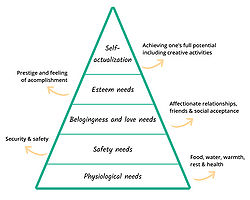Intrinsic and Extrinsic motivation
| Line 7: | Line 7: | ||
== Theory of human motivation – Maslow<ref name="MotivationMaslow"/> == | == Theory of human motivation – Maslow<ref name="MotivationMaslow"/> == | ||
| − | [[File:Wiki Maslow Pyramid.jpg|200px| | + | [[File:Wiki Maslow Pyramid.jpg|200px|thumb|250px| Maslow's hierarchy of needs - image <ref name="MotivationTurienzo"/>adapted by Maria Elena Igarzabal ]] |
Maslow’s pyramid was created in 1943 and in a graphic way, categorizes human motivations into five sets of goals, which are called basic needs. These are physiological, safety, love, esteem, and self-actualization. Additionally, the author suggests that | Maslow’s pyramid was created in 1943 and in a graphic way, categorizes human motivations into five sets of goals, which are called basic needs. These are physiological, safety, love, esteem, and self-actualization. Additionally, the author suggests that | ||
According to this theory, the basic needs are arranged according to is hierarchy or prepotency and shows a path that must be fulfilled to achieve happiness. The search for desired elements will be what generates motivation. It also suggests that the basic goals are related to each other, meaning that if all needs are unsatisfied and the organism is then dominated by physiological needs, all further needs may become non-existent or be pushed into the background. A person that is extremely tired and has not slept for a drastic amount of time, its organism will focus all its energy on achieving restful sleep. | According to this theory, the basic needs are arranged according to is hierarchy or prepotency and shows a path that must be fulfilled to achieve happiness. The search for desired elements will be what generates motivation. It also suggests that the basic goals are related to each other, meaning that if all needs are unsatisfied and the organism is then dominated by physiological needs, all further needs may become non-existent or be pushed into the background. A person that is extremely tired and has not slept for a drastic amount of time, its organism will focus all its energy on achieving restful sleep. | ||
Revision as of 12:32, 19 February 2022
Contents |
Abstract
Motivation can be defined as “the need or reason for doing something.”[1] Deep down, what do people want? Why do people adhere to norms? Is everyone equally motivated by money, social life and fame?
The purpose of this article is to dive into the concept of intrinsic and extrinsic motivations, the 16 universal human needs, and their practical implication. Starting from the theory of human motivation of A.H. Maslow, this paper shows the characteristics of basic needs and their hierarchy of prepotency arrangement. Subsequently, the distinction of intrinsic and extrinsic motivations is carried out and the concept of multifaceted motivation is tackled.
Theory of human motivation – Maslow[2]

Maslow’s pyramid was created in 1943 and in a graphic way, categorizes human motivations into five sets of goals, which are called basic needs. These are physiological, safety, love, esteem, and self-actualization. Additionally, the author suggests that According to this theory, the basic needs are arranged according to is hierarchy or prepotency and shows a path that must be fulfilled to achieve happiness. The search for desired elements will be what generates motivation. It also suggests that the basic goals are related to each other, meaning that if all needs are unsatisfied and the organism is then dominated by physiological needs, all further needs may become non-existent or be pushed into the background. A person that is extremely tired and has not slept for a drastic amount of time, its organism will focus all its energy on achieving restful sleep.
Limitations
Intrinsic and Extrinsic Motivations
Multifaceted Motivations and applications
Annotated bibliography
- ↑ Cambridge University, Cambridge Advanced Learner's Dictionary & Thesaurus, https://dictionary.cambridge.org/dictionary/english/motivation .
- ↑ A.H. Maslow, A theory of Human Motivation.
- ↑ Ruben Turienzo,El pequeño libro de la motivación,2016.
Cite error: <ref> tag with name "MotivationKasser" defined in <references> is not used in prior text.
Cite error: <ref> tag with name "Motivation" defined in <references> is not used in prior text.
Cite error: <ref> tag with name "MotivationKreps" defined in <references> is not used in prior text.
Cite error: <ref> tag with name "Motivation" defined in <references> is not used in prior text.